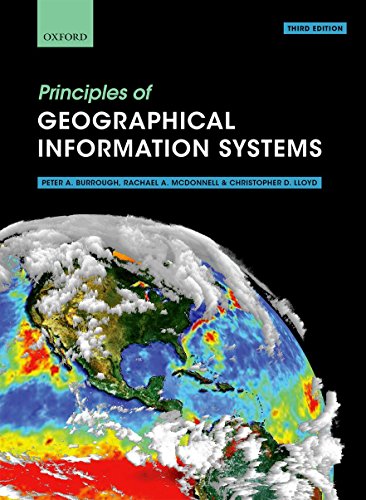Principles Geographical Information Systems by Burrough Professor (7 results)
FeedbackSearch filters
Product Type
- All Product Types
- Books (7)
- Magazines & Periodicals (No further results match this refinement)
- Comics (No further results match this refinement)
- Sheet Music (No further results match this refinement)
- Art, Prints & Posters (No further results match this refinement)
- Photographs (No further results match this refinement)
- Maps (No further results match this refinement)
- Manuscripts & Paper Collectibles (No further results match this refinement)
Condition Learn more
- New (4)
- As New, Fine or Near Fine (1)
- Very Good or Good (2)
- Fair or Poor (No further results match this refinement)
- As Described (No further results match this refinement)
Binding
Collectible Attributes
- First Edition (No further results match this refinement)
- Signed (No further results match this refinement)
- Dust Jacket (No further results match this refinement)
- Seller-Supplied Images (2)
- Not Print on Demand (7)
Language (1)
Free Shipping
Seller Location
Seller Rating
-
Principles of Geographical Information Systems for Land Resources Assessment: 12 (Monographs on Soil Resources Survey)
Published by Oxford University Press, United Kingdom, Oxford, 1986
ISBN 10: 0198545924 ISBN 13: 9780198545927
Language: English
Seller: WorldofBooks, Goring-By-Sea, WS, United Kingdom
Paperback. Condition: Very Good. Geographical information systems are being increasingly used by governmental and non-governmental environmental resource and planning agencies to record the characteristics of the earth's spatial resources - land, water, soil, vegetation, people - in digital form. These digital databases are replacing paper maps as data stores because they permit quick, quantitative analysis of complex spatial data and modelling of proposed spatial policies. Technical information about the principles and applications of geographical information systems is spread over a wide range of disciplines, ranging from cartography to spatial statistics to computer science. This book is one of the first to bring these principles together so that environmental scientists of all kinds, from university students to resource managers, can find out the essentials of these new tools and learn how to use them. It includes extensive lists of references, allowing readers to pursue specialist topics further. The book has been read, but is in excellent condition. Pages are intact and not marred by notes or highlighting. The spine remains undamaged.
-
Principles of Geographical Information Systems for Land Resources Assessment: 12 (Monographs on Soil Resources Survey)
Published by Oxford University Press, 1986
ISBN 10: 0198545630 ISBN 13: 9780198545637
Language: English
Seller: WeBuyBooks, Rossendale, LANCS, United Kingdom
Condition: Good. Most items will be dispatched the same or the next working day. A copy that has been read but remains in clean condition. All of the pages are intact and the cover is intact and the spine may show signs of wear. The book may have minor markings which are not specifically mentioned. Ex library copy with usual stamps & stickers.
-
Principles of Geographical Information Systems for Land Resources Assessment (Monographs on Soil Resources Survey, Band 12)
Published by Oxford University Press, 1986
ISBN 10: 0198545924 ISBN 13: 9780198545927
Language: English
Seller: Buchpark, Trebbin, Germany
£ 9.22
Convert currency£ 20.75 shipping from Germany to United KingdomQuantity: 1 available
Add to basketCondition: Sehr gut. Zustand: Sehr gut | Sprache: Englisch | Produktart: Bücher.
-
Principles of Geographical Information Systems
Published by Oxford University Press, 2015
ISBN 10: 0198742843 ISBN 13: 9780198742845
Language: English
Seller: THE SAINT BOOKSTORE, Southport, United Kingdom
£ 65.36
Convert currencyFree shipping within United KingdomQuantity: Over 20 available
Add to basketPaperback / softback. Condition: New. New copy - Usually dispatched within 4 working days. 787.
-
Principles of Geographical Information Systems
Published by Oxford University Press, 2015
ISBN 10: 0198742843 ISBN 13: 9780198742845
Language: English
Seller: Kennys Bookshop and Art Galleries Ltd., Galway, GY, Ireland
£ 85.58
Convert currency£ 2.60 shipping from Ireland to United KingdomQuantity: 3 available
Add to basketCondition: New. Principles of Geographical Information Systems provides a thorough, broad-ranging account of the theory and practice of GIS. It explains why spatial data and the information systems based on them are so important in the modern world for solving a range of practical problems. Num Pages: 352 pages, Illustrations. BIC Classification: RGW. Category: (P) Professional & Vocational; (UP) Postgraduate, Research & Scholarly; (UU) Undergraduate. Dimension: 266 x 197 x 18. Weight in Grams: 750. . 2015. 3rd Edition. Paperback. . . . .
-
Principles of Geographical Information Systems
Published by Oxford University Press, 2015
ISBN 10: 0198742843 ISBN 13: 9780198742845
Language: English
Seller: Kennys Bookstore, Olney, MD, U.S.A.
£ 88.65
Convert currency£ 2.22 shipping from U.S.A. to United KingdomQuantity: 3 available
Add to basketCondition: New. Principles of Geographical Information Systems provides a thorough, broad-ranging account of the theory and practice of GIS. It explains why spatial data and the information systems based on them are so important in the modern world for solving a range of practical problems. Num Pages: 352 pages, Illustrations. BIC Classification: RGW. Category: (P) Professional & Vocational; (UP) Postgraduate, Research & Scholarly; (UU) Undergraduate. Dimension: 266 x 197 x 18. Weight in Grams: 750. . 2015. 3rd Edition. Paperback. . . . . Books ship from the US and Ireland.
-
Principles of Geographical Information Systems (Paperback)
Published by Oxford University Press, Oxford, 2015
ISBN 10: 0198742843 ISBN 13: 9780198742845
Language: English
Seller: Grand Eagle Retail, Mason, OH, U.S.A.
£ 116.83
Convert currency£ 37.06 shipping from U.S.A. to United KingdomQuantity: 1 available
Add to basketPaperback. Condition: new. Paperback. Geographical data are used in so many aspects of our lives today, ranging from disaster relief operations through to finding directions on our mobile phones. We can all be data collectors, adding locational information as we capture digitally our day-to-day experiences. Geographical Information Systems (GIS) are the software tools that facilitate this, turning the raw data into useful information that can help us understand our worlds better.Principles of Geographical Information Systems presents a thorough overview of the subject, exploring both the theoretical basis of GIS, and their use in practice. It explains how data on the worldare converted into digital form and the analytical capabilities used to bring understanding to a range of areas of interest and issues. Spatial data are usually based on two, dichotomous paradigms: exactly defined entities in space, such as land parcels and urban structures, or the continuous variation of single attributes, such as temperature or rainfall. The adoption of one or the other influences how the geographical data are structured in the GIS and the types ofanalysis possible. A further area of focus in the book concerns the problems of data quality and how statistical errors in spatial data can affect the results of spatial modelling based on the twoparadigms of space. Fuzzy logic and continuous classification methods are presented as methods for linking the two spatial paradigms. The book concludes with an overview of current developments and trends in providing spatial data to an ever-expanding global community of users. Principles of Geographical Information Systems provides a thorough, broad-ranging account of the theory and practice of GIS. It explains why spatial data and the information systems based on them are so important in the modern world for solving a range of practical problems. Shipping may be from multiple locations in the US or from the UK, depending on stock availability.





